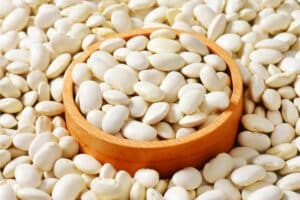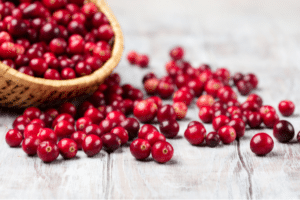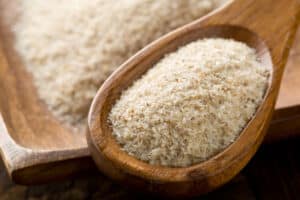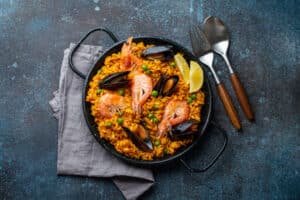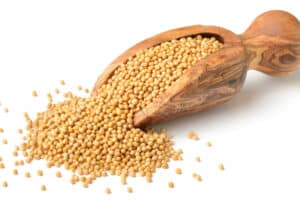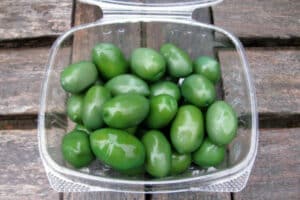Navy Beans are super common in the US and have an interesting history both botanically and in global food management.
As a result, they are abundant in the US and are likely to have been eaten by most Americans at some point, while in Europe they may have slightly different beans.
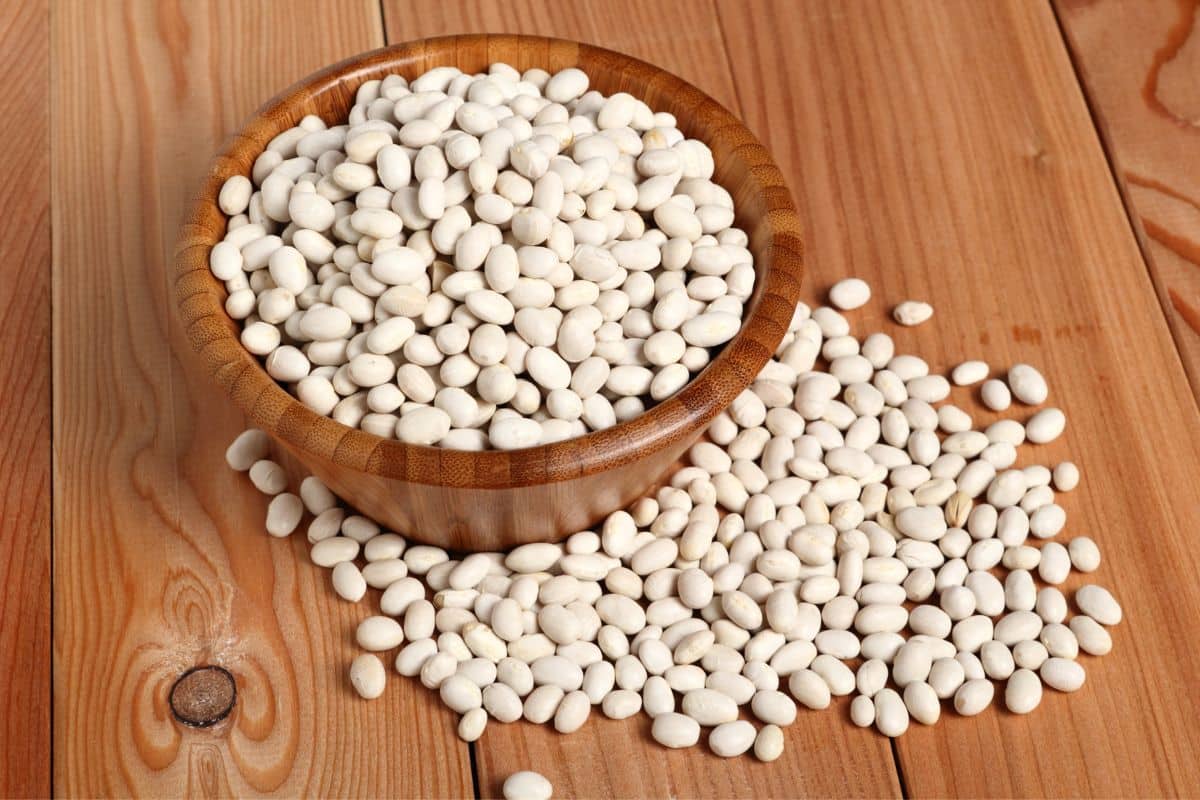
Either way, if you can’t find Navy Beans in your local store you might not be so familiar with other beans, so we are here to suggest the kinds of beans that are suitable substitutes for Navy Bean in any recipe that calls for the latter.
What Is A Navy Bean?
Navy Beans are a common bean in the Americas, you may recognize them from their Goya bean can, but the bean can be called a few things, such as Boston Bean or haricot bean.
The bean can often be distinguished when dry due to its naturally oblong shape, like a tic-tac. Most beans curl or have something simple which makes the bean unique.
The plant they come from grows well in the Americas and can actually be either a vine or bushy plant depending on variety.
Like any bean, they can either come in a dried format where they are hard and require cooking to soften, or they come in a canned format where they are likely already
If you have ever had a baked bean dish in the US it may well be a Navy bean, mainly due to how the bean was naturalized in the Americas on purpose for food production – as a result they are very abundant. But if you can’t find them, they are easy to swap out both in cooked and dried form.
Substitutes For Navy Beans
Luckily, there are many beans out there which you can substitute for the common Navy Bean, here are our favorites.
1. Cannellini Bean
The cannellini bean is very similar to the Navy Bean, and the Cannellini bean is probably one of the most common in areas of Europe.
Most European canned bean goods likely contain Cannellini beans, such as the infamous Heinz Baked Bean.
In Italy, they are commonly used in minestrone soup and pasta e fagioli. Interestingly, they actually originate from Argentina, where they are also pretty common.
No matter how you use them, they are a white bean like a Navy Bean so have a similar taste and texture.
Cannellini beans are basically a white kidney bean so they are a little larger in size than a Navy bean as a result.
2. Butter Beans
The more mature version of Phaseolus lunatus is the butter bean, often regarded as many people’s favorite bean, and for good reason.
The butter bean earned this name from their internal texture being quite buttery and smooth, which is true.
In this way they are quite similar to other white beans, and if anything might be a little richer, more smooth, and less toothsome. This said, their flavor is really similar to Navy beans.
It should be noted that the butter bean is generally a little bigger than a navy bean. The butter bean is common in Europe but is also common in the Americas as well, but originated in the South Americas, Peru to be exact.
3. Lima Beans
Many may not have realized that Lima beans and butter beans are theoretically the same bean.
While butter beans are more mature beans from the Phaseolus lunatus, the Lima bean is just a younger version of the bean. When they are younger like this they are more green as we often expect of Lima beans.
As a result of being younger, they are often a little lighter in flavor, and a little more toothsome in their texture.
Their flavor is a bit more toned down than their elder butter bean, but is a good substitute for navy beans in general. Like their elder butter bean, the lima bean is a bit bigger than Navy beans.
4. Great Northern Beans
The Great Northern bean is quite common in the Americas, like Navy Beans. South American Indian natives are termed to have developed what we call the Great Northern bean a long time ago, alongside corn.
They are botanically similar to Navy Beans in that they are both classed as Phaseolus vulgaris. They were subsequently distributed across the Americas by migrating farmers.
Spanish explorers exported much of these beans into Africa and what was called the ‘New World’ which is why they are a global product, especially enjoyed in modern USA.
Nonetheless, they are quite similar to Navy Beans. They have a delicate flavor like Navy Beans that is quite nutty like other varieties of Phaseolus. They are generally a bit larger than Navy Beans but are still smaller than Cannellini
5. Giant Beans (Gigantes Plaki)
These are a type of bean found mainly in Greece. If you have ever had Greek meze, which is like Greek tapas, they have a common dish called Gigantes Plaki that is basically cooked Giant white beans.
If you can find these beans that are particularly large, larger than butter beans, albeit basically the same, they are really great.
These giant beans are super satisfying and ideal for eating with sauces and mopping up with bread. If you can find them in the US, they are a great bean to use in lieu of Navy Beans.
They are much larger but with a similar taste and texture and just bring something a little different.
6. Marrow Beans
Marrow beans are an interesting bean that can be an interesting swap for Navy beans. Back in the 1850s, they were probably the most popular baking bean before the Navy bean took over.
One thing about the marrow bean is that they have a unique meaty flavor that is quite distinct from other beans.
They are a great swap for navy beans and have a similar texture, being a plump white bean. They are a little bigger, so this and their unique meaty flavor should be kept in mind.
Many find that marrow beans taste like bacon, so they are a cool and interesting swap for a dish you are making, but if you want the blank canvas of a white bean there could be better options.
7. Black Beans
Black beans are another really common bean in the US and in South America and are used in many dishes that you likely have tried. Most refried bean dishes will use black beans, for example.
Black beans have a pretty bean heavy flavor, which is why they can be used in things like refried beans, as they impart a flavor.
Navy beans are blander on the other hand and a little more creamy than a black bean. All this said, using black beans in place of navy beans can totally work and is actually an interesting swap in some cases, perfect in any Mexican inspired dish.
8. Kidney Beans
Kidney beans get their name from the curved shape and color that make them look like little kidneys, and ironically they are actually good for kidney health.
Kidney beans are a really common ingredient and super easy to find across the world, being particularly high in protein.
They have a gentle flavor that is mild, so can actually be pretty similar to navy beans.
An issue with kidney beans is that they contain protein called phytohemagglutinin which is a little toxic, so many suggest rinsing them quite a bit out of the can as well as cooking them a little more than usual – the worst that can occur is an upset stomach, though.
9. Pinto Beans
Pinto beans are a fun variety of common beans, like Navy beans, but have an unusual skin. The skin of the bean is spotted like a Pinto horse, but has a white interior. This skin is where they get their name ‘pinto’ which means ‘painted’ in Spanish.
They are a common crop in both Southwestern US and Mexico, but are common in Brazilian and other Latin cuisines.
Beyond simply looking good, they are very similar to a navy bean and have the same mild flavor that is perfect to buff out any stew or filling.
Their texture is pretty similar too, but the skin itself adds a little chewy element, but this is quite nice in certain dishes.
10. Chickpeas
Chickpeas, sometimes known as garbanzo beans, are a type of legume that isn’t really a bean at all. They are super popular in Europe and North Africa, as well as the Middle East.
Without getting into the botanical specifics, while they aren’t theoretically a bean, they can be a good substitute for a white bean, and can be high in protein.
Chickpeas are really common basically everywhere and are really easy to grow. In Latin America, they might be called a garbanzo bean, but they are the same as chickpeas.
Chickpeas are much different in shape to a white bean, like a Navy bean. Chickpeas are round and have a small skin that can be removed easily.
Chickpeas are generally pretty bland and have the same sort of nutty earthiness that you get from a white bean like a Navy bean.
Chickpeas come in cans, but if you can find jarred chickpeas, these are much higher quality and are buttery and soft in comparison.
11. Sauced Canned Beans
When you are really in a pinch you might only be able to find sauced beans, like baked tomato beans or ranch style beans that are pre-prepared.
Often these beans are sauced and covered in a seasoned sauce that brings a unique flavor to the beans. These can work well as a substitute for simple beans, just be sure the sauce you are buying can easily be paired with the flavors of the dish you plan on making.
Final Thoughts
As you can see, there are plenty of varieties of beans out there. Put simply, the Navy bean is relatively bland in its flavor, while high in nutrition.
So when looking for a substitute, another white bean that has a mild flavor is the best choice. Something like a Great Northern bean, butter bean, or Cannellini bean can be the best choice to not change the flavors of a dish. But when you are really in a pinch, any canned bean goods can work.
Frequently Asked Questions
While the bean has many names, in the US and also Australia they are commonly called Navy Beans. Historically, beans are a common dish to be served in the navy.
Beans last a while and can be preserved for a decent amount of time, as well as being nutritionally sound – making them an ideal dish to serve to hungry sailors and soldiers alike.
While Navy Beans are super common in the Americas, when US troops, particularly the navy, were stationed in Australia during the Second World War they brought their beans with them.
In Queensland, at the military base Kingaroy, the Navy Bean was actively naturalized in the area.
As beans grow easily, you can easily just plant one bean and get a plant, they were used to feed the troops that were there in the rather desolate Queensland of that era.
As a result, these beans became popular in Australia as a result of US presence during WW2, and are commonly called Navy Beans or Yankee Beans as a nod to their originators in the area.


